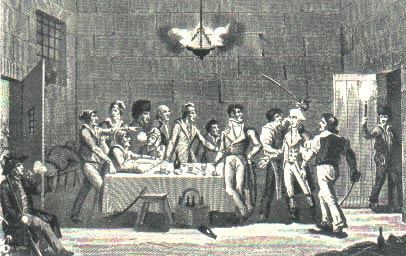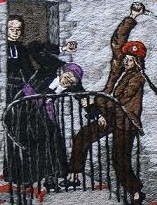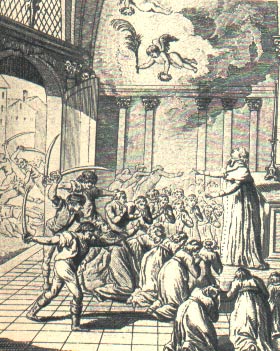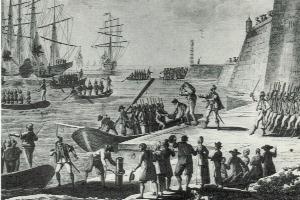The French Revolution
 O
n November 2nd, 1789, the ‘’ Assemblée Constituante’’ decided that the properties of the Clergy "were given to the Nation " to pay off the national debt.
In 1791, the Contrai street House was closed and declared property of the Nation.
O
n November 2nd, 1789, the ‘’ Assemblée Constituante’’ decided that the properties of the Clergy "were given to the Nation " to pay off the national debt.
In 1791, the Contrai street House was closed and declared property of the Nation.
 O
n June 14th 1791, all the Christian Schools of Reims were put on vacancy.
O
n June 14th 1791, all the Christian Schools of Reims were put on vacancy.
O n July 12th 1790, the civil Constitution of the clergy was adopted, establishing the election of priests and bishops and sentencing to death the Clergy refusing the schism.

I nvited to swear "the oath of loyalty’’ to the nation, the law, the king and the “ civil constitution of the clergy ", the Brothers answered massively "that they could not nor had not to take the oath ". Having become public primary school teachers, they could not "teach the Revolutionary Catechism, recognize the bishop of the Marne Department, nor lead the children to the mass of a sworn priest ".
T he refractory Brothers had to abandon their schools and their communities, without any compensation and they should hide themselves.
A s all other teaching congregations, the Brothers Institute was abolished on August 18th 1792 by a decree of the Legislative Assembly " considering that a really free State had to suffer no corporation, even those which, dedicated to state education, deserved well of the homeland."


T he prison of the Carmelites is settled in the old monastery of the Carmelites. The refractory Clerics are massacred in particularly violent conditions, under the direction of police commissioner Stanislas-Marie Maillard, executive of the orders of the Supervisory committee. This one settled a court in the convent. He judged and condemned one by one all those who appeared in front of him "by force ". The door opened and as soon as the members of a religious order who refused to take the oath in the civil Constitution of the clergy, crossed the threshold, they fell under lances or bayonets. These massacres lasted from September 2d to 5th 1792.
T he General Secretary of the Institute, Nicolas Leclerc (Brother Salomon) was massacred in the prison of the Carmelites in Paris on September 2nd 1792.



O n April 23rd 1793, the Convention confirmed "the immediate deportation to French Guiana, of Clerics and Brothers who did not take the oath ".
O n January 24th 1793, the school was rented to a blanket manufacturer.
O n June 29th 1794, the houses of 95, 96, 97 ‘’ Rue Neuve’’, all three were rented, declared National Property, were put on sale.
O n March 2nd 1796, "the Brothers’ house, Rue Neuve was partly used as military barracks and partly as a state school.
O n June 20th 1796, the School was sold to Messrs Barbier and Baudet-Fassin. It became and remainded the " Spinning-mill of the Brothers " until 1880.
A t the end of the French Revolution, nothing remained of John-Baptist de La Salle’s schools. Everything was to be reconstructed.